Text
Slide 8 of The Multisexuality of Erasure, Part 2!
5 notes
·
View notes
Text








This is Part 2 of The Multisexuality of Erasure series, focusing on gender on stage! There are a couple of video posts that go with this part (after the last pic), so stay tuned!
16 notes
·
View notes
Text




Today, August 13, is International Left Handers Day! Did you know Vince Clarke is left-handed? Swipe to see some clippings and tweets where this fact comes up! According to the website for Left Handers Day, “Apart from the general creativity of left-handers, the left-handed brain is at the centre of both the sense of rhythm and the perception of pitch, which helps to explain why so many successful composers and musicians are left-handed.” Interestingly, Vince still plays the guitar right-handed.
9 notes
·
View notes
Text





Vince Clarke, describing his relationship with Andy Bell in Erasure:
"We have a very good relationship. We love each other. And when we work, it's like purely the art of writing songs, the craft of writing songs, and creating something that's new and original, hopefully. And it's always--ALWAYS inspirational. So it's been very good, and we've been lucky to find each other, I think."
(source)
9 notes
·
View notes
Text




It's time for my very first Erasure meme! I've also included the original meme - "love is stored in the cat" - along with a couple of quotes that demonstrate just how much love is stored in this band. Many thanks to my friend Sidurii (@my-name-is-siduri) for the drawing!
9 notes
·
View notes
Text
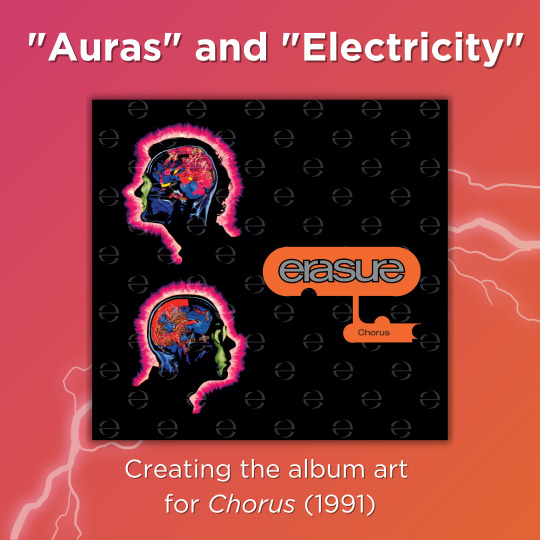
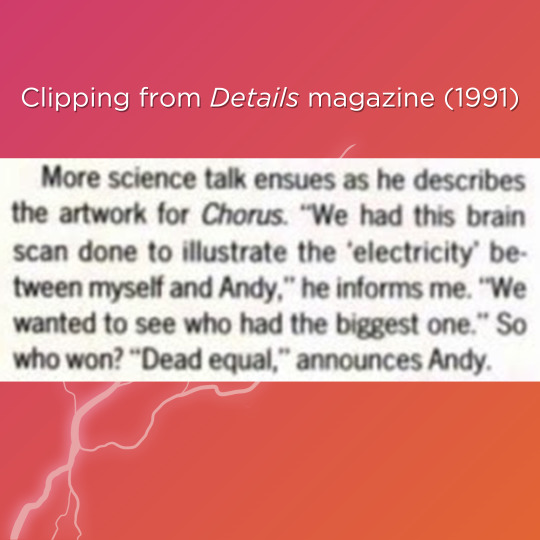
One of Erasure’s most striking album covers is the one for Chorus (1991). How did the concept come about, and what do the images represent? If you’d like to know the story, keep reading.
The album covers vary by country and format, but in all cases, their heads are lit up in pink, and you can see the insides of their brains in vibrant technicolour. These visual concepts came from the group. After five years together, Clarke and Bell were feeling more connected than ever, and were looking to represent the strength of their bond in different ways. Andy Bell had wanted to capture their “auras” in photographs, and Vince Clarke was interested in illustrating the “electricity” generated between the two of them.
To start off, Monica Curtin photographed the band members’ heads in silhouette, and they had brain scans done (the liner notes actually give thanks to the MRI Centre in London!). Clarke told Details magazine that he wanted to see “who had the biggest one”. And who did? According to Bell, they were “dead equal.”
When came time to assemble the cover, the designers (Me Company) made use of many innovative techniques. In a brilliant article for Classic Pop, designer Siân Cook–who was working for the Me Company at the time–explained the process. “The coloured areas inside the heads were colour photocopy collages, while the pink/purple auras around the outside of the heads were taken from images of Kirlian plant photography which were manipulated and wrapped around the silhouettes.” The medical theme was carried through in other ways; the subtle “e” pattern on the album cover and liner notes was “inspired by medicine packaging.”
In the liner notes, there are several stock images of happy, photogenic people enjoying their lives. Cook said that these photos referenced “big pharma promo brochures”. Andy Bell had more to add: “these pictures are Corporate America, or Corporate Anywhere”. To him, they represented a lifestyle that people were supposed to aspire to - which was a “farce”. If they were real, he joked, they’d feature “ugly people–like us!”
SOURCES:
Bardin, Brantley. “Erasure.” Details, Nov. 1991, p. 129.
Chorus, 1991. Retrieved via the Internet Archive.
Dineley, Andrew. “Pop Art: Vince Clarke.” Classic Pop, Mar. 2021. Web article accessed 3 Aug. 2023.
“Erasure Interview by Verónica Castro (La Movida, Mexico, 1991) .” La Movida, 1991, https://www.youtube.com/watch?v=dZ46ykCUbkQ. Video uploaded by bwlvideo on YouTube. Accessed 3 Aug. 2023.
8 notes
·
View notes
Text









In this series, I’ll explore multisexuality in the work of Erasure. I’ll explain what multisexuality is, then use it as a framework to understand different parts of their art. This post will be about Erasure’s music. Swipe through to read the image version, and click here to read the text version (including transcriptions of all the clippings)!
18 notes
·
View notes
Text
Supporting video 2 of 2 for this post on Les Child!
6 notes
·
View notes
Text
Supporting video 1 of 2 for this post on Les Child!
7 notes
·
View notes
Text

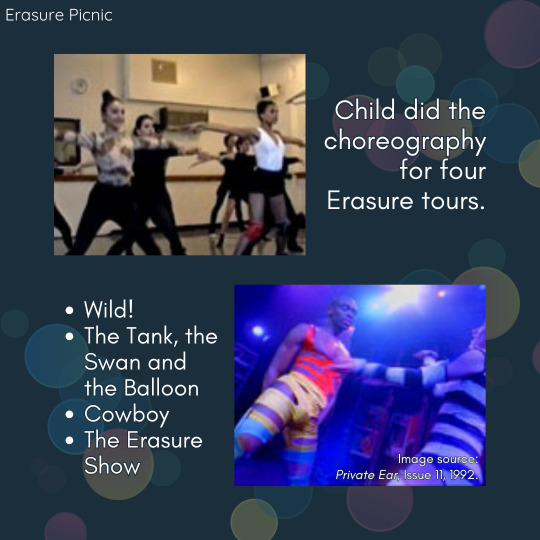

In honour of both Black History Month and the UK’s LGBT+ History Month, let’s shine a spotlight on a key figure in Erasure’s brilliant stage shows - Les Child!
Child has had a prolific and storied career, working as a dancer, choreographer, and innovator in the arts. He danced with several groundbreaking troupes throughout the ‘70s and 80s, and also founded some of his own–including House of Child, the UK’s first voguing group. In the ‘80s, he branched out into choreography for music videos, which brought him into pop star circles, and at the dawn of the ‘90s, he set his sights on live tours.
According to his CV on HeadNod Agency, the first tour Child ever choreographed was Erasure’s Wild! Tour (1989-1990). Child was fond of Erasure’s music, and told Private Ear in 1992 that “it makes life a lot easier when it comes to choreographing a show if you enjoy the music”. He would go on to do the choreography for The Tank, the Swan, and the Balloon (1992), Cowboy (1996-1997), and The Erasure Show (2005). Indeed, Child seems to have choreographed more tours for Erasure than for any other band or artist. He also starred in Erasure’s short film “Dr. Jekyll and Mistress Hyde” (2003), and forged an enduring friendship with Andy Bell.
Child’s work with Erasure is really special to me. His choreography is undeniably dazzling on its own, and the dancers deliver it with athleticism and aplomb. But I’d also argue that it adds to the music, making it even better. My favourite example is “Love to Hate You” from The Tank. In this performance--which Bell introduces as “the gayest of gay tangos”--two pairs grace the stage: one male-male, one female-female. By the end of the song, they’ve swapped partners multiple times. (Check out video 1 and video 2 to see this in action.) When I first saw this, I was charmed. It was unexpected, yet it seemed natural: a nod to the sexual fluidity that runs through Erasure’s music and art. I feel that Child truly got Erasure, knew what made them “them”, and made it sparkle.
SOURCES: Cover image and CV from Les Child’s page on HeadNod Agency (headnodagency.com). “Ear to the Ground”. Private Ear, Issue 11 (1992). Retrieved via a capture of the official Erasure website (Internet Archive). December 4, 2004. “Erasure - Dr Jekyll and Mistress Hyde (Directed By Vince Clarke)”. Original video from Erasure (Mute Records), 2003. Uploaded by Erasure Música y Amigos, retrieved via YouTube. “Life Drawing with Sue Tilley featuring Les Child as model and muse.” Uploaded by Sue Tilley, retrieved via YouTube, November 27, 2021. Staples, L. “From leather daddies to ‘Drag race’, dissecting the revolutionary history of the queer aesthetic.” British Vogue. July 24, 2021.
7 notes
·
View notes
Text



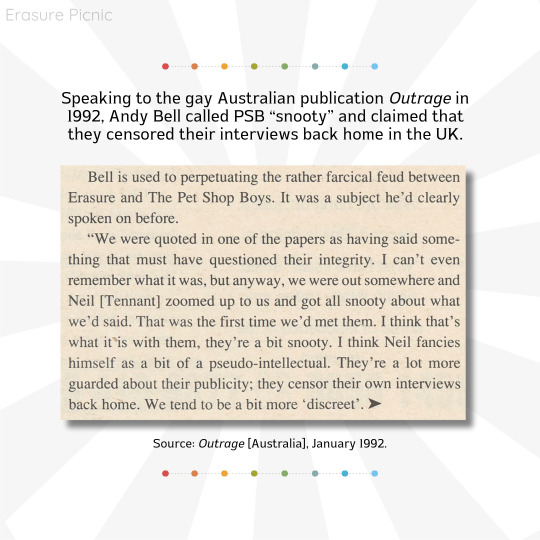

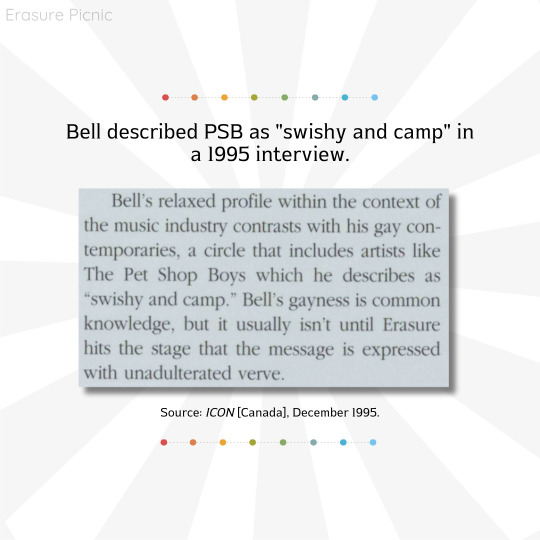
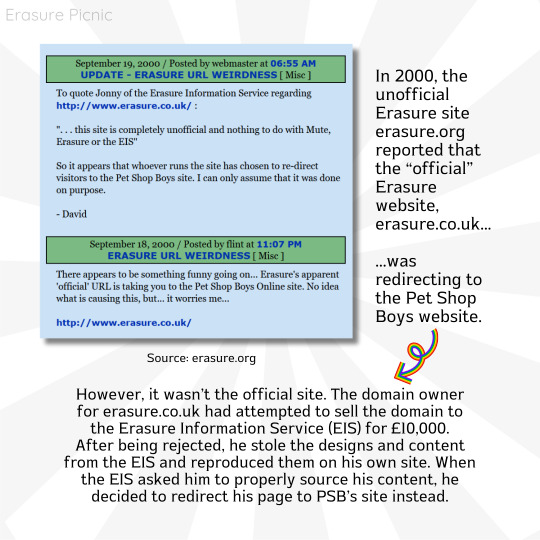


You may have thought the PSB vs. Erasure series was over - but there’s more! I collected some tidbits that either couldn’t fit in the original series, or that I’d found after the last post. So here’s part 5!
After Erasure released their debut album, Clarke was asked in an interview if he thought the radio wouldn't play Erasure because their genre (synthpop) wasn't in fashion anymore. He disagreed, citing PSB as an example of a synthpop band who were doing well. Source: Melody Maker, May 31, 1986.
In August 1991, PSB did a stint as radio DJs on BBC Radio One, playing a surprisingly wide variety of artists. There were only two artists they wouldn’t play: Deacon Blue…and Erasure. (However, one of the songs they played–a 20-minute megamix by 808 State–sampled “Just Can’t Get Enough”, a song written by Vince Clarke!) Source: Literally, Nov. 1991.
Speaking to Outrage in 1992, Bell called PSB “snooty” and said they censored their interviews in the UK. Source: Outrage [Australia], Jan. 1992.
In 1994, Neil Tennant claimed that PSB weren't a 'perv' pop duo– “that’s more like Erasure.” (A decade earlier, in his career at Smash Hits, Tennant had coined the term ‘pervy synth duo’ to refer to Eurythmics.) Source: Vox, Jan. 1, 1994.
Bell described PSB as "swishy and camp" in a 1995 interview. Source: ICON, Dec. 1995.
In 2000, the unofficial Erasure site erasure.org reported that the “official” Erasure website, erasure.co.uk, was redirecting to the PSB website. However, it wasn’t the official site. The domain owner for erasure.co.uk had failed to sell the domain to the Erasure Information Service (EIS) for £10,000. After being rejected, he stole the designs and content from the EIS and reproduced them on his own site. When the EIS asked him to properly source his content, he decided to redirect his page to PSB’s site instead.
Ian “H” Watkins from the band Steps once told Neil Tennant that his brother had seen one of their gigs in Wales. Eventually, he realized it was Erasure. Tennant was “not impressed”. Source: NME, Nov. 2020.
In 2019, Bell went back on his word–he told journalist Steve Pafford that Erasure and PSB WERE rivals! Source: Stevepafford.com, Jun. 5, 2020.
#erasure#erasure band#vince clarke#andy bell#pet shop boys#pet shop boys vs erasure#neil tennant#chris lowe
18 notes
·
View notes
Text
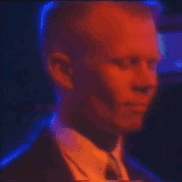

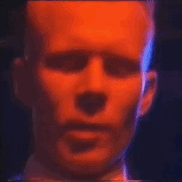

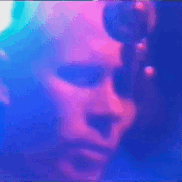
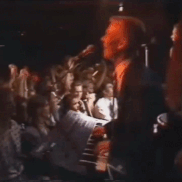
A gifset of Vince Clarke being incredibly happy while performing in Karlsson, Sweden, May 1, 1986. This was the first time in Clarke's career that he enjoyed performing live. In a 1985 interview in Melody Maker, he told journalist Kris Kirk, "I've never experienced pleasure in playing live before. … But there's nothing like playing non-stop dance music loud for feeling good. … And the other reason it's working for me is that I get on so well with Andy."
14 notes
·
View notes
Text
11 notes
·
View notes
Text
6 notes
·
View notes
Text


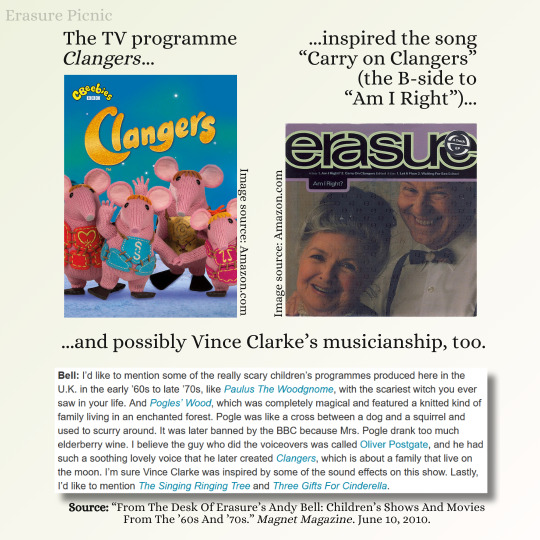


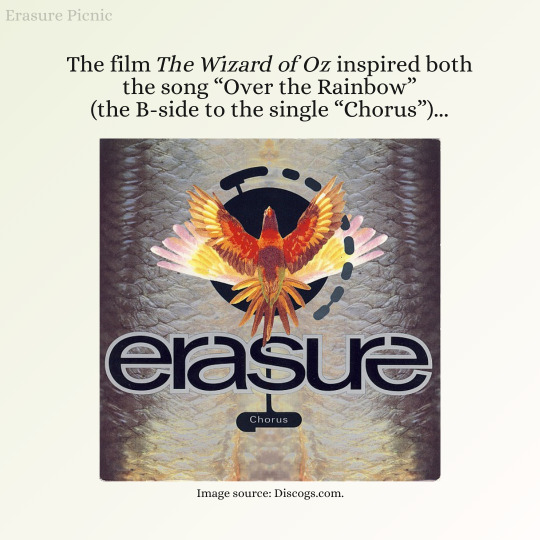
From the start, Erasure have been influenced by children’s media, and they’ve brought those influences into their art. However, in 1991-1992, this fascination would reach its peak, with the band creating several works influenced by various books, TV shows, and films they’d seen as children. Here are five such works from what I call Erasure’s “fairy era”. Click through to see them all.
1. The East German fantasy film “The Singing Ringing Tree” (1957) inspired Erasure’s “Siren Song”, and Andy Bell has also talked about its influence on his work.
2. In 2010, Bell was the guest editor of the online Magnet Magazine, where he shared some of his life experiences and influences. One of his features was on the children’s TV programmes that had come from the UK in the ‘60s and ‘70s. Bell mentioned the show Clangers, about “a family that live on the moon”, and suggested that Vince Clarke was inspired by the sound effects on that show. The B-side to “Am I Right” (1992) was titled “Carry on Clangers”.
3. The video for “Breath of Life” (1992) was inspired by the Alice in Wonderland book series, and featured several nods to the story, including “an Alice character ushering Andy through the Looking Glass, the hookah-smoking caterpillar, singing oysters, and dubious-looking mushrooms, with lush painted sets and backdrops evoking the most beloved scenes of Lewis Carroll’s trippy tales” (Mat Smith, Chorus reissue).
4. According to Mat Smith, who interviewed Erasure for the Chorus reissue, the story of The Lion, the Witch and the Wardrobe inspired the lyrics for the song “Home”.
5. The film The Wizard of Oz inspired both the song “Over the Rainbow” (the B-side to the single “Chorus”), and the band’s Phantasmagorical Tour (1992), which featured several references to the film. Before “Blue Savannah”, Bell gives a bawdy retelling of one of the film’s pivotal scenes. He also sings the film’s iconic song “Over the Rainbow” in ruby slippers.
#erasure#erasure band#andy bell#vince clarke#the singing ringing tree#clangers#alice in wonderland#the lion the witch and the wardrobe#the wizard of oz
16 notes
·
View notes
Text
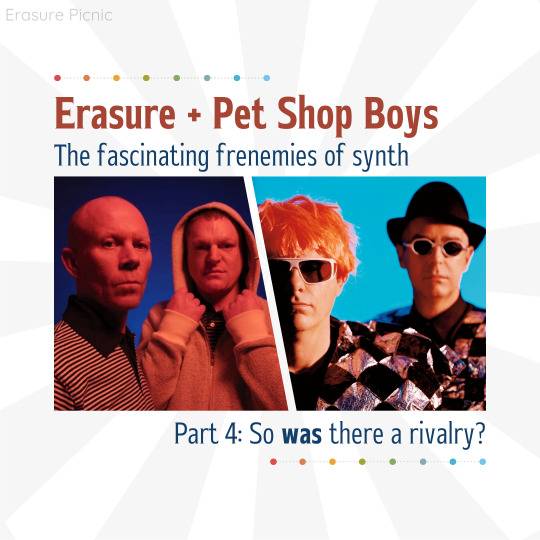

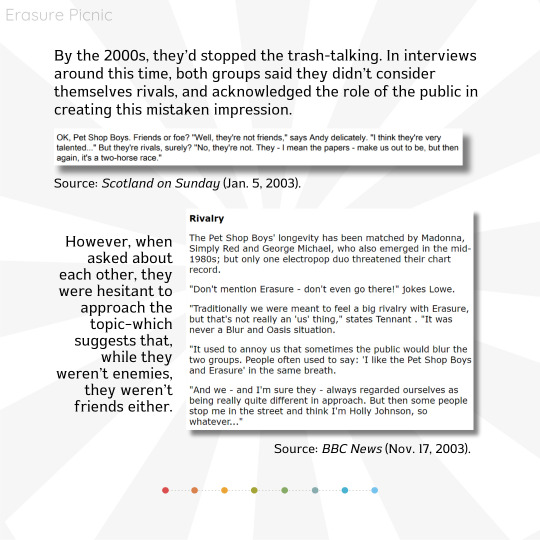
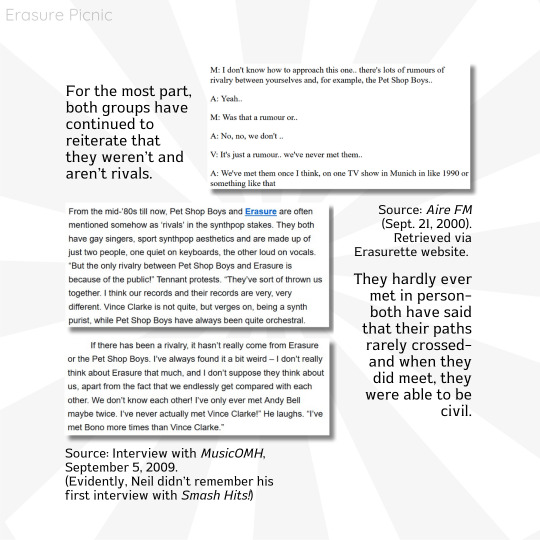
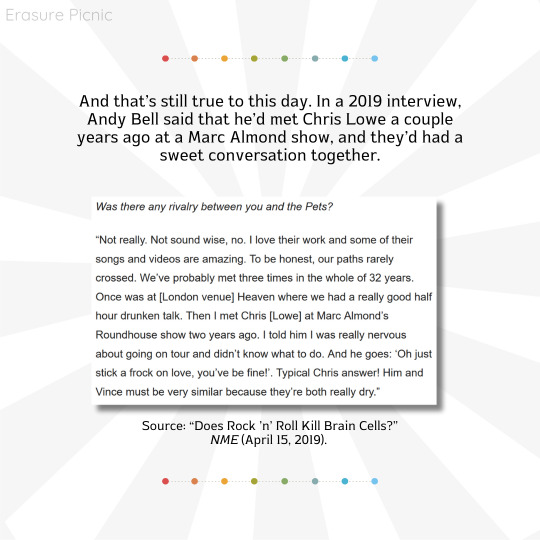

We’ve arrived at the final post in the Pet Shop Boys/Erasure “rivalry” series. I hope you’ve enjoyed the ride!
So, was there a “rivalry” at all? The two groups disagreed on a lot of things and made their fair share of snippy comments about each other, goaded on by journalists and fans’ comparisons. But they also talked about enjoying each other’s music and didn’t go out of their way to avoid one another. For instance, they appeared at the same London Pride festival in 1997, performing within an hour of each other.
By the 2000s, they’d stopped the trash-talking. In interviews around this time, both groups said they didn’t consider themselves rivals, and acknowledged the role of the public in creating this mistaken impression. However, when asked about each other, they were hesitant to approach the topic–which suggests that, while they weren’t enemies, they weren’t friends either.
For the most part, both groups have continued to reiterate that they weren’t and aren’t rivals. They hardly ever met in person–both have said that their paths rarely crossed–and when they did meet, they were able to be civil. And that’s still true to this day. In a 2019 interview, Andy Bell said that he’d met Chris Lowe a couple years ago at a Marc Almond show, and Chris had cracked a gentle joke, even calling Andy “love” as he did. It seems there are no hard feelings between the two bands.
My thoughts? The rivalry was mostly created and sustained by journalists and fans, and the bands themselves played a fairly small role in it. While they weren’t friends, there wasn’t any real hate between them. They may have even found it fun to make all those petty comments.
39 notes
·
View notes
Text
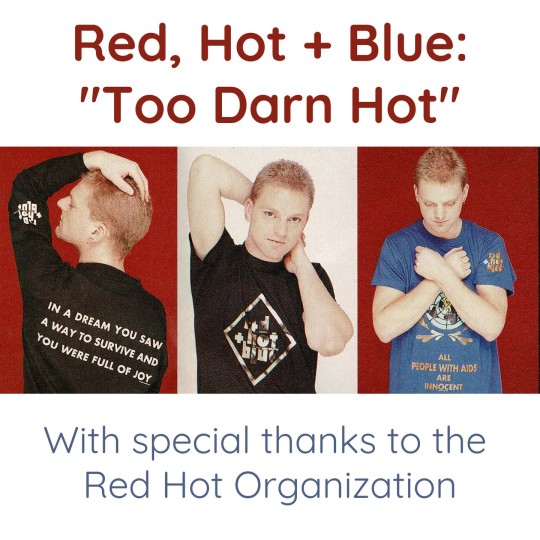

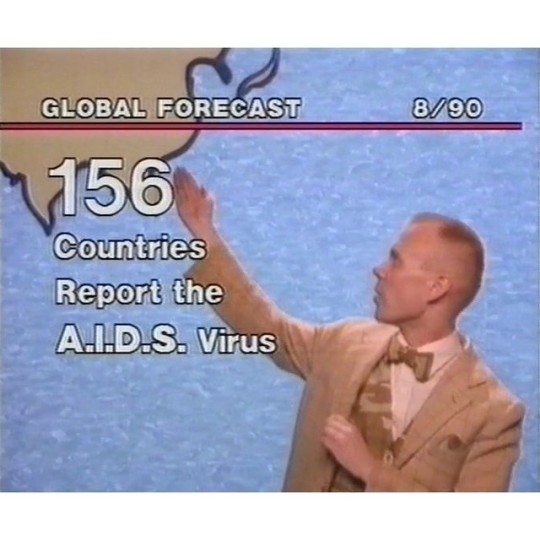
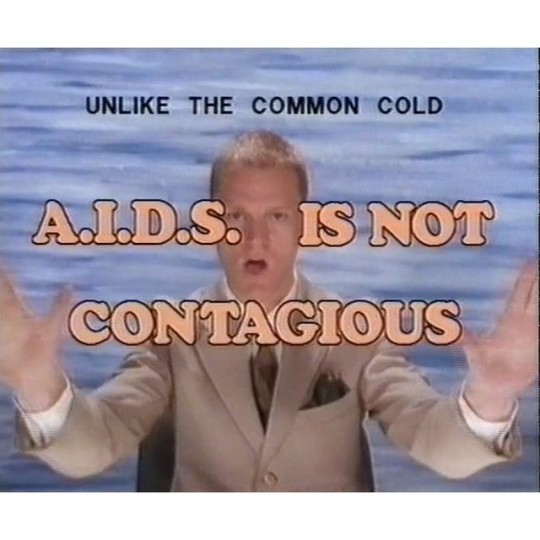
This post examines Erasure's involvement in the Red, Hot & Blue project.
In 1989, Leigh Blake and John Carlin, two figures in the New York creative scene, were finding themselves affected by the AIDS crisis, which was having a devastating impact on so many talented artists, intellectuals and friends. Frustrated by the government’s persistent inaction, they looked to their community to enact change. They had an idea. What if they could put out an album of songs by Cole Porter, covered by some of the hottest musical acts, with the proceeds going to AIDS organizations? And what if they paired those songs with music videos directed by great filmmakers?
Early on, the organizers asked Erasure to take part, and the band agreed–they’d always done AIDS benefits and felt that it was more important than ever to raise awareness about the disease. They contributed a steamy, electrified cover of “Too Darn Hot”, along with a powerful music video, directed by Adelle Lutz and Sandy McLeod. Bell and Clarke play weather forecasters reporting on the crisis, with the “heat” of the song used as a metaphor for the effects of the epidemic. It’s the project’s most political video, blending the “weather” concept with footage of AIDS protests and facts about HIV. The film clip was so incisive that when the Red, Hot + Blue TV special was aired on ABC, some of its more pointed messages were altered or removed by the network. Thankfully, a year later, the uncensored version was played on Bravo, and it was seen in 30 countries around the world.
Bell also did a front-page feature for Record Mirror in 1990 on the initiative. In the article, he explains why he was determined to contribute, shares more facts about AIDS, and poses in Red, Hot + Blue merchandise. His frankness, conviction and optimism make it a bracing, worthwhile read.
In spite of funding struggles and censorship, Red, Hot + Blue was a success, selling over a million copies worldwide and raising millions of dollars for AIDS charities like ACT UP and AmFAR. Its success helped establish the Red Hot nonprofit, which would go on to release over 15 collaboration albums, numerous TV specials and media events. And it’s still going on today: follow the Red Hot Organization on social media to learn more.
Sources:
General information: the official website of Red Hot Organization; newspaper clippings; books from Internet Archive Magazine cover: Lansure's Music Paraphernalia and Michael Kane (Record Mirror, Oct. 20, 1990) Screen captures of music video: Internet Archive
#erasure#erasure band#andy bell#vince clarke#red hot and blue#red hot organization#erasure's activism#adelle lutz#sandy mcleod
12 notes
·
View notes